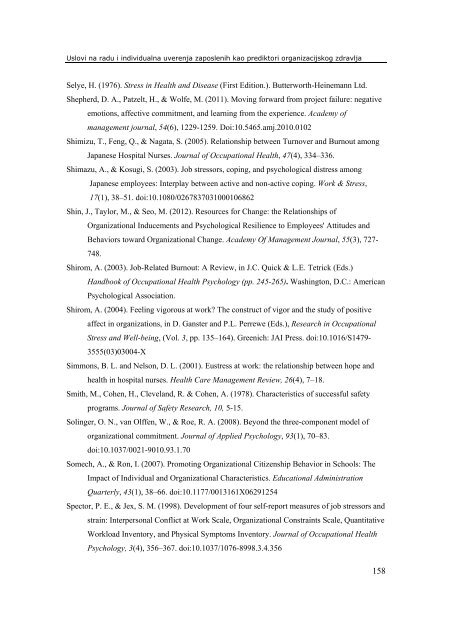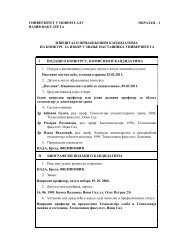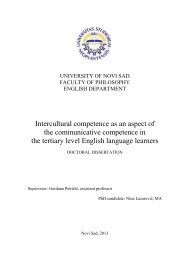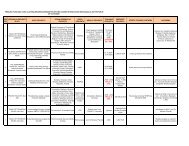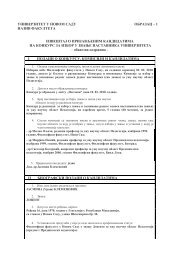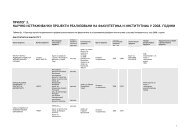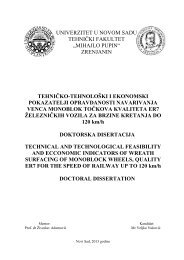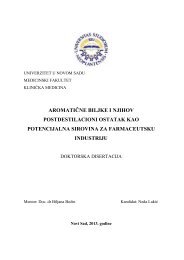Univerzitet u Novom Sadu Filozofski fakultet Odsek za psihologiju ...
Univerzitet u Novom Sadu Filozofski fakultet Odsek za psihologiju ...
Univerzitet u Novom Sadu Filozofski fakultet Odsek za psihologiju ...
Create successful ePaper yourself
Turn your PDF publications into a flip-book with our unique Google optimized e-Paper software.
Uslovi na radu i individualna uverenja <strong>za</strong>poslenih kao prediktori organi<strong>za</strong>cijskog zdravlja<br />
Selye, H. (1976). Stress in Health and Disease (First Edition.). Butterworth-Heinemann Ltd.<br />
Shepherd, D. A., Patzelt, H., & Wolfe, M. (2011). Moving forward from project failure: negative<br />
emotions, affective commitment, and learning from the experience. Academy of<br />
management journal, 54(6), 1229-1259. Doi:10.5465.amj.2010.0102<br />
Shimizu, T., Feng, Q., & Nagata, S. (2005). Relationship between Turnover and Burnout among<br />
Japanese Hospital Nurses. Journal of Occupational Health, 47(4), 334–336.<br />
Shimazu, A., & Kosugi, S. (2003). Job stressors, coping, and psychological distress among<br />
Japanese employees: Interplay between active and non-active coping. Work & Stress,<br />
17(1), 38–51. doi:10.1080/0267837031000106862<br />
Shin, J., Taylor, M., & Seo, M. (2012). Resources for Change: the Relationships of<br />
Organi<strong>za</strong>tional Inducements and Psychological Resilience to Employees' Attitudes and<br />
Behaviors toward Organi<strong>za</strong>tional Change. Academy Of Management Journal, 55(3), 727-<br />
748.<br />
Shirom, A. (2003). Job-Related Burnout: A Review, in J.C. Quick & L.E. Tetrick (Eds.)<br />
Handbook of Occupational Health Psychology (pp. 245-265). Washington, D.C.: American<br />
Psychological Association.<br />
Shirom, A. (2004). Feeling vigorous at work? The construct of vigor and the study of positive<br />
affect in organi<strong>za</strong>tions, in D. Ganster and P.L. Perrewe (Eds.), Research in Occupational<br />
Stress and Well-being, (Vol. 3, pp. 135–164). Greenich: JAI Press. doi:10.1016/S1479-<br />
3555(03)03004-X<br />
Simmons, B. L. and Nelson, D. L. (2001). Eustress at work: the relationship between hope and<br />
health in hospital nurses. Health Care Management Review, 26(4), 7–18.<br />
Smith, M., Cohen, H., Cleveland, R. & Cohen, A. (1978). Characteristics of successful safety<br />
programs. Journal of Safety Research, 10, 5-15.<br />
Solinger, O. N., van Olffen, W., & Roe, R. A. (2008). Beyond the three-component model of<br />
organi<strong>za</strong>tional commitment. Journal of Applied Psychology, 93(1), 70–83.<br />
doi:10.1037/0021-9010.93.1.70<br />
Somech, A., & Ron, I. (2007). Promoting Organi<strong>za</strong>tional Citizenship Behavior in Schools: The<br />
Impact of Individual and Organi<strong>za</strong>tional Characteristics. Educational Administration<br />
Quarterly, 43(1), 38–66. doi:10.1177/0013161X06291254<br />
Spector, P. E., & Jex, S. M. (1998). Development of four self-report measures of job stressors and<br />
strain: Interpersonal Conflict at Work Scale, Organi<strong>za</strong>tional Constraints Scale, Quantitative<br />
Workload Inventory, and Physical Symptoms Inventory. Journal of Occupational Health<br />
Psychology, 3(4), 356–367. doi:10.1037/1076-8998.3.4.356<br />
158


